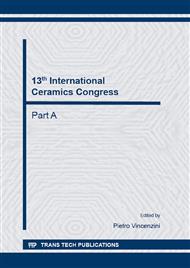[2]
Information on http: /www. unep. org/PDF/PressReleases/GlobalMercuryAssessment2013. pdf.
Google Scholar
[3]
I. Ali, V. K. Gupta, Advances in water treatment by adsorption technology, Nature Protocols, 1(6) (2007) 2661-2667.
Google Scholar
[4]
V.K. Gupta, P.J.M. Carrott, M.M.L. Ribeiro Carrott, Z. Suhas, Low-Cost Adsorbents: Growing Approach to Wastewater Treatment—a Review, Critical Reviews in Environmental Science and Technology 39(10) (2009) 783-842.
DOI: 10.1080/10643380801977610
Google Scholar
[5]
H. L. Clack, Estimates of increased black carbon emissions from electrostatic precipitators during powdered activated carbon injection for mercury emissions control. Environmental Science and Technology 46(13) (2012) 7327-7333.
DOI: 10.1021/es3003712
Google Scholar
[6]
S. Tong, M. Fan, L. Mao L., C. Q. Jia, Sequential extraction study of stability of adsorbed mercury in chemically modified activated carbons. Environmental Science and Technology 45(17) (2011) 7416-7421.
DOI: 10.1021/es201399d
Google Scholar
[7]
D. Cuhadaroglu, O.A. Uygun, Production and characterization of activated carbon from a bituminous coal by chemical activation. African Journal of Biotechnology, 7(20) (2008) 3706-3713.
Google Scholar
[8]
A. Belgacem, M. Belmedani, R. Rebiai, H. Hadoun, Characterization, analysis and comparison of activated carbons issued from the cryogenic and ambient grinding of used tires, Chemical Engineering Transactions 32 (2013) 1705-1710.
Google Scholar
[9]
E.L. Mui, W.H. Cheung, G. McKay, Tyre char preparation from waste tire rubber for dye removal from effluents, Journal of Hazardous Materials 175 (2010) 151-158.
DOI: 10.1016/j.jhazmat.2009.09.142
Google Scholar
[10]
D. C. K. Ko, E. L. K. Mui, K. S. T. Lau, G. McKay, Production of activated carbons from waste tire process design and economical analysis, Waste Management, 24(9) (2004) 875-888.
DOI: 10.1016/j.wasman.2004.03.006
Google Scholar
[11]
J. D. Martínez, N. Puy, R. Murillo, T. García, M. V. Navarro, A. M. Mastral, Waste tyre pyrolysis - A review, Renewable and Sustainable Energy Reviews 23 (2013) 179-213.
DOI: 10.1016/j.rser.2013.02.038
Google Scholar
[12]
N. Antoniou, A. Zabaniotou, Features of an efficient and environmentally attractive used tyres pyrolysis with energy and material recovery, Renewable and Sustainable Energy Reviews 20 (2013) 539-558.
DOI: 10.1016/j.rser.2012.12.005
Google Scholar
[13]
B.E. Warren, X-ray Diffraction in Random Layer Lattices, Phys. Rev. 59 (1941) 693-698.
DOI: 10.1103/physrev.59.693
Google Scholar
[14]
R. E. Franklin, The Structure of Graphitic Carbons, Acta Cryst. 4 (1951) 253-261.
Google Scholar
[15]
M. Christy, M.R. Jisha, A.R. Kim, K.S. Nahm, D. J. Yoo, E.K. Suh, Pyrolytic carbon derived from sorona as anode materials for Li ion batteries, Indian Journal of Engineering & Materials Sciences 17 (2010) 343-348.
Google Scholar
[16]
H. Fujimoto, K. Tokumitsu, A. Mabuchi, and T. Kasuh and M. Shiraishi, New structural parameters for carbon: comprehensive crystallization index and cavity index, Carbon 32 (1994) 1249-1252.
DOI: 10.1016/0008-6223(94)90109-0
Google Scholar
[17]
I.R. Lewis, H.G.M. Edwards Eds, Handbook of Raman Spectroscopy Marcel Dekker, Inc, (2002).
Google Scholar
[18]
A.C. Ferrari, J. Robertson, Interpretation of Raman spectra of disordered and amorphous carbon, Phys. Rev. B 61 (2000) 14095.
DOI: 10.1103/physrevb.61.14095
Google Scholar
[19]
A.C. Ferrari, J. Robertson, Resonant Raman spectroscopy of disordered, amorphous, and diamond-like carbon, Phys. Rev. B 64 (2001) 75414.
Google Scholar


